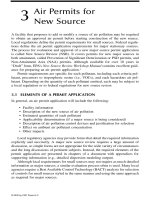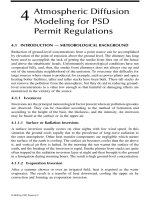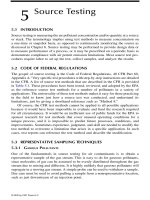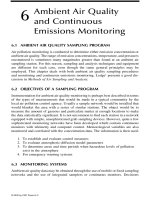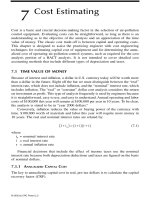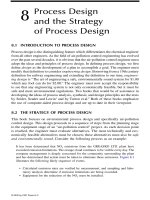AIR POLLUTION CONTROL EQUIPMENT SELECTION GUIDE - CHAPTER 1 doc
Bạn đang xem bản rút gọn của tài liệu. Xem và tải ngay bản đầy đủ của tài liệu tại đây (2.41 MB, 30 trang )
AIR
POLLUTION
CONTROL
EQUIPMENT
SELECTION
GUIDE
© 2002 by CRC Press LLC
LEWIS PUBLISHERS
A CRC Press Company
Boca Raton London New York Washington, D.C.
Kenneth C. Schifftner
AIR
POLLUTION
CONTROL
EQUIPMENT
SELECTION
GUIDE
This book contains information obtained from authentic and highly regarded sources. Reprinted material
is quoted with permission, and sources are indicated. A wide variety of references are listed. Reasonable
efforts have been made to publish reliable data and information, but the author and the publisher cannot
assume responsibility for the validity of all materials or for the consequences of their use.
Neither this book nor any part may be reproduced or transmitted in any form or by any means, electronic
or mechanical, including photocopying, microfilming, and recording, or by any information storage or
retrieval system, without prior permission in writing from the publisher.
The consent of CRC Press LLC does not extend to copying for general distribution, for promotion, for
creating new works, or for resale. Specific permission must be obtained in writing from CRC Press LLC
for such copying.
Direct all inquiries to CRC Press LLC, 2000 N.W. Corporate Blvd., Boca Raton, Florida 33431.
Trademark Notice:
Product or corporate names may be trademarks or registered trademarks, and are
used only for identification and explanation, without intent to infringe.
Visit the CRC Press Web site at www.crcpress.com
© 2002 by CRC Press LLC
No claim to original U.S. Government works
International Standard Book Number 1-58716-069-2
Library of Congress Card Number 2002017493
Printed in the United States of America 1 2 3 4 5 6 7 8 9 0
Printed on acid-free paper
Library of Congress Cataloging-in-Publication Data
Schifftner, Kenneth C.
Air pollution control equipment selection guide / Kenneth Schifftner.
p. cm.
Includes index.
ISBN 1-58716-069-2 (alk. paper)
1. Air Purification Equipment and supplies. I. Title.
TD889 .S35 2002
628.5
′
3 dc21 2002017493
A
cknowledgments
I thank the following people for applying their considerable talents to the
creation of this book:
Roy Prosser, draftsman, designer, and consummate good friend who
produced sketches and drawings to supplement the text.
Tracy Leigh Schifftner, daughter, skilled technician, writer, and computer
whiz who helped this computer novice clear some considerable hurdles
regarding the writing and composing of the book.
Carolyn Ann Schifftner, daughter, athlete and scholar, whose humor and
positive attitude made the rough spots more bearable.
Patricia Ann Schifftner, wife and efficient expeditor, who prodded me
along with consistent “When are you ever going to finish that book?”
encouragement.
© 2002 by CRC Press LLC
The Author
Kenneth Schifftner has more than 35 years of experience in the area of air
pollution control. Starting as a draftsman in 1966, he has been involved
with more than 800 successful gas cleaning projects. He holds a Bachelor
of Science degree in Mechanical Engineering from the New Jersey Institute
of Technology.
An author of more than 50 technical articles on gas cleaning technology,
Schifftner was co-author with Howard Hesketh of the technical book
Wet
Scrubbers
(Technomic Publishers, CRC Press), which is in its second printing,
and provided the chapter on particulate removal in the
Air Pollution Engi-
neering Manual
published by Van Nostrand Reinhold. Schifftner has been an
instructor for numerous courses sponsored by the EPA, provided academic
and corporate technical training seminars, served as an expert witness
regarding air pollution control technology, and functioned as a consultan
t
to small and large firms interested in solving air pollution problems.
Schifftner has also received four U.S. and foreign patents to date on novel
mass transfer devices, which are used worldwide.
His experience includes the application of gas cleaning technology to
hazardous and medical waste incinerators, boilers, pulp bleach plants, lime
kilns, dissolving tank vents, fume incinerators, rotary dryers, tank vents,
b
lenders/mixers, plating operations, metals cleaning, semiconductor man-
ufacturing processes, and other systems. He has also applied dry filtration
technology to woodwaste fired boilers. He has designed odor control sys-
tems using a wide variety of oxidants including hydrogen peroxide, sodium
hypochlorite, ozone, chlorine dioxide, and potassium permanganate. He has
researched and solved entrainment and visible plume problems in both
conventional and novel gas cleaning systems. He is a specialist in the col-
lection of fine particles that can affect public health.
Schifftner is a former chairman of the Environmental Control Division
of the American Society of Mechanical Engineers (ASME). He is an active
member of ASME, the Semiconductor Safety Association, and Technical
Association for the Pulp and Paper Industry (TAPPI).
A resident of Encinitas, California, Schifftner is currently the produc
t
and district manager for Bionomic Industries Inc., which is based in Mah-
wah, New Jersey.
© 2002 by CRC Press LLC
Contributors
Kenneth Schifftner
Bionomic Industries Inc.
Oceanside, California
Dan Banks
Banks Engineering, Inc.
Tulsa, Oklahoma
Deny Claffey
and Michael Claffey
Allied Mechanical
Las Vegas, Nevada
J
oseph Colannino
J
ohn Zink Company, LLC
Tulsa, Oklahoma
Dan Dickeson
Lantec Products, Inc.
Agoura Hills, California
Wayne T. Hartshorn
Hart Environmental, Inc.
Lehighton, Pennsylvania
Joe Mayo
Advanced Environmental
Systems, Inc.
Frazer, Pennsylvania
Bob Taylor
BHA Group, Inc.
Kansas City, Missouri
© 2002 by CRC Press LLC
Introduction
Welcome to the
Air Pollution Control Equipment Selection Guide
.
The selection of air pollution control hardware can be a daunting task.
There are literally hundreds of equipment vendors offering a wide variety
of air pollution control technologies. If this book has one purpose, it is to
make that selection process easier.
In the following pages, we have labored to include the important
information required by people interested in air pollution control that can
b
e used in selecting the proper equipment for any air pollution control
problem. There are no endorsements of one technology over another.
Instead, the information is based on the type of technology used by the
device, its effectiveness, its size and relative cost, and its common appli-
cation(s). From this general information, one can decide the best technology
to use or, lacking a clear cut decision, choose the areas in which to obtain
more detailed information.
To provide an understanding of the terminology used and the basic
technology applied to particulate capture, gas cooling, and gaseous contam-
inant control, we included an “Air Pollution Control 101” chapter. In this
chapter, the basics of air pollution control are described. Inertial forces such
as impaction and interception are discussed, along with less “forceful” forces
such as diffusion, electrostatics, Brownian motion, and phoretic forces. Any,
or all of these forces may be used by a particular pollution control device.
Not only does this section serve as an introduction to the concepts mentioned
in this book, but it also enables the reader to save time by quickly referring
b
ack to this section for clarification of terminology or of the technologic
descriptions. Although you are welcome to, you do not have to go to another
text on air pollution control basics. Even if you are an experienced applica-
tions engineer, we suggest that you review this section first to obtain an
understanding of the terms we use and the context in which we use them.
The subsequent sections purposely use a common structure. The sections
are divided by the primary technology used, that is, quenching, cooling,
particulate removal, gas absorption, and so on. Within these sections, specific
technology types are mentioned in detail. This structure is intended to make
it easier for the reader to jump from section to section as technologies are
compared. In each section, we define the type of gas cleaning device, the
b
asic physical forces used in it, its common sizes and costs, and its mos
t
© 2002 by CRC Press LLC
common uses.
C
aveats an
d
suggest
i
ons a
b
out app
l
y
i
ng t
h
e tec
h
no
l
ogy are
mentioned as an aid. These comments are not intended to be limiting. Quite
to the contrary, descriptions of the devices are intended to let the reader
select the type of equipment that, after review of the information, best suits
his or her application. There may be occasional mentioning of a particular
vendor or device type by tradename; however, this is not intended to be an
endorsement of that device.
We define the equipment by device type based on primary function,
not by trade name or most common application. The index, however, is
structured to help you link the application to the equipment. This was
done intentionally to speed up the selection process. If you are researching
an application in a specific industry, it is suggested that you go to the
index first. Look up the application, and it will direct you to the common
devices used.
Many air pollution control problems are solved not with one type o
f
device, but with a variety of designs applied synergistically. An example
may be a hot gas source (say, an incinerator) the gases of which must first
b
e cooled (quencher), the particulate removed (Venturi scrubber or precipi-
tator), and the acid gases absorbed (packed or tray scrubber). To make this
task easier, we included sections on each of these devices and noted where
they are commonly used in concert with other equipment. You can imagine
that there are near endless varieties of equipment combinations. That is why
we highlight the primary functional area of the device. Many times, the
designs can be combined in novel fashion to suit a particular application.
You are encouraged to be inventive.
Wherever possible, we have included current photographs or drawings
of typical equipment within that device type. This was intended to help you
obtain an understanding of the equipment arrangement and to help you
recognize existing devices that, perhaps, no longer are properly marked or
identified. It is like a spotter’s guide for air pollution control equipment.
Again, showing a photo is not to be construed as an endorsement of that
particular design. It is merely a representation of a common type of device
within that category.
As you may have noted already, the publisher has chosen the authors
partly for their knowledge and partly for their conversational writing style.
We hope this combination will make this book an easy to read, technologi-
cally accurate reference book that will make the selection of air pollution
control equipment easier for you.
© 2002 by CRC Press LLC
Contents
Chapter 1 Air pollution control 101
It is separation technology
Wet collection of particulate
Dry collection
Gas absorption
The concept of number of transfer units in absorption
The transfer unit concept in gas absorption
Hybrid systems
Chapter 2 Adsorption devices
Device type
Typical applications and uses
Operating principles
Primary mechanisms used
Design basics
Operating suggestions
Chapter 3 Biofilters
Device type
Typical applications and uses
Operating principles
Primary mechanisms used
Design basics
Operating suggestions
Chapter 4 Dry cyclone collectors
Device type
Typical applications and uses
Operating principles
Primary mechanisms used
Design basics
Operating/application suggestions
© 2002 by CRC Press LLC
C
h
apter 5 E
l
ectrostat
i
c prec
i
p
i
tators
Device type
Typical applications and uses
Operating principles
Primary mechanisms used
Creation of charge
Field charging
Diffusion charging
Design basics
Resistivity of dust
Operating suggestions
Air load/gas load testing
Alignment
Thermal expansion
Air in-leakage
Rapping
Insulator cleaning
Purge heater and ring heater systems
Process temperature
Fuel changes
Chapter 6 Evaporative coolers
Device type
Typical applications and uses
Primary mechanisms used
Design basics
Types of gas cooling
Gas conditioning
Basic sizing
The all important atomization
A case history example
Cost considerations
Operating suggestions
Chapter 7 Fabric filter collectors
Device type
Typical applications and uses
Operating principles
Primary mechanisms used
Design basics
Operating suggestions
Chapter 8 Fiberbed filters
Device type
Typical applications and uses
Acid mist
© 2002 by CRC Press LLC
Asp
h
a
l
t process
i
ng
Plasticizer/vinyl/PVC processing
Coating/laminating
Electronics
Textile processing
Metalworking
Lube oil vents and reservoirs
Incinerator emissions
Internal combustion engine crankcase vents
Precious metal recovery
Vacuum pumps
Operating principles
Primary mechanisms used
Design basics
Operating/application suggestions
Filter cleaning
Fiberbed filter life
Fire protection if the contaminant is combustible
Chapter 9 Filament (mesh pad) scrubbers
Device type
Typical applications
Operating principles
Primary mechanisms used
Design basics
Operating suggestions
Chapter 10 Fluidized bed scrubbers
Device type
Typical applications and uses
Operating principles
Primary mechanisms used
Design basics
Operating suggestions
Chapter 11 Mechanically aided scrubbers
Device type
Typical applications and uses
Operating principles
Primary mechanisms used
Design basics
Operating suggestions
Chapter 12 Packed towers
Device type
Typical applications and uses
© 2002 by CRC Press LLC
Operat
i
ng pr
i
nc
i
p
l
es
Primary mechanisms used
Design basics
Counter flow
Cross flow
Operating suggestions
Chapter 13 Settling chambers
Device type
Typical applications and uses
Operating principles
Primary mechanisms used
Design basics
Operating/application suggestions
Chapter 14 Spray towers/scrubbers
Device type
Typical applications and uses
Operating principles
Primary mechanisms used
Design basics
Operating suggestions
Chapter 15 Nitrogen oxide (NO
x
) control
Device type
Typical applications and uses
Combustion sources
Operating principles
Primary mechanisms used
Design basics
Different forms of NO
x
NO
x
measurement units
Thermal NO
x
Fuel-bound NO
x
Thermal-NO
x
control strategies
Dilution strategies
Staging strategies
Postcombustion strategies
Operating/application suggestions
Chapter 16 Thermal oxidizers
Device type
Typical applications
Operating principles
Primary mechanisms used
Design basics
Operating suggestions
© 2002 by CRC Press LLC
C
h
apter
1
7
T
ray scru
bb
ers
Device type
Typical applications and uses
Operating principles
Primary mechanism used
Design basics
Operating suggestions
Chapter 18 Vane type scrubbers
Device type
Typical applications
Operating principles
Primary mechanisms used
Design basics
Operating suggestions
Chapter 19 Venturi scrubbers
Device type
Typical applications
Operating principles
Primary mechanisms used
Design basics
Operating/application suggestions
Chapter 20 Wet electrostatic precipitators
Device type
Typical applications and uses
Primary mechanisms used
Design basics
Types of wet precipitators
Configuration
Arrangement
Irrigation method
Selecting a wet electrostatic precipitator
Operating suggestions
Appendix A: Additional selected reading
General topics
Industrial ventilation
Air pollution engineering manual
Fan engineering
McIllvaine scrubber manual
Psychrometric tables and charts
Cameron hydraulic book
Mass transfer operations
Various corrosion guides
Publication details
© 2002 by CRC Press LLC
A
ppen
di
x
B
:
Li
st o
f
p
h
oto contr
ib
utors
© 2002 by CRC Press LLC
© 2002 by CRC Press LLC
chapter 1
Air pollution control 101
Having spent more than 30 years in the air pollution control industry, I am
still amazed by how the basics of air pollution control are misunderstood
by so many.
Our newspapers have numerous articles regarding the need to control
toxic or carcinogenic substances, but rarely do you see an article explaining
how
it is done. In this chapter we will explore the basics of air pollution
control, how the devices work, and, in doing so, introduce some of the
terminology used in the industry.
It is separation technology
Air pollution control can be generally described as a “separation” technology.
The pollutants, whether they are gaseous, aerosol, or solid particulate, are
separated
from a carrier gas, which is usually air. We separate these substances
because, if we don’t, these pollutants may adversely affect our health and that
of the environment. Of primary importance is the effect of the pollutants on
our respiratory system, where the impact is most noticeable.
Gaseous pollutants are compounds that exist as a gas at normal envi-
ronmental conditions. Usually, “normal” is defined as ambient conditions.
These gases may have, just moments before release, been in a liquid or even
solid form. For the purposes of the air pollution device, however, the state
they are in just prior to entering the control device is what is most important.
Aerosols are finely divided solid or liquid particles that are typically
under 0.5
µ
m diameter. They often result from the sudden cooling (conden-
sation) of a gaseous pollutant, through partial combustion, or through a
catalytic effect in the gas phase. In the latter condition, a pollutant in the gas
phase may combine to form an aerosol in the presence of, for example, a
metal co-pollutant. Acid aerosols such as SO
3
, for example, can form in the
presence of vanadium particulate that may be evolved through the combus-
tion of oil containing vanadium compounds. Solid metals in a furnace can
sublime (change phase from solid directly to gaseous) in the heat of an
incinerator, then cool sufficiently to form a finely divided aerosol.
© 2002 by CRC Press LLC
Solid particulate can be evolved through combustion or through com-
mon processing operations such as grinding, roasting, drying, calcining,
coating, or metallizing.
Whatever the state of the pollutant, the function of the air pollution
control device is to separate that pollutant from the carrier gas so that our
respiratory system does not have to.
Our respiratory system is our natural separation system. Figure 1.1
depicts the major portions of the human respiratory system. Large particles
are removed in the larger openings of the upper respiratory area, smaller
particles are removed in the more restricted bronchial area, and the tiniest
particles are (hopefully) removed in the tiny alveolar sacs of the lungs.
Air pollution control truly mimics Mother Nature in its separation function.
In general, low energy input wet-type (those using water as the scrubbing
medium) gas cleaning devices remove large particles, higher energy devices
remove smaller particles, and even higher energy (or special technology) devices
remove the finest pollutants. In order of
decreasing
pollutant size, it goes like this:
The larger the particle, or liquid droplet for that matter, the easier it is
to separate from the carrier gas.
Figure 1.1
Respiratory system diagram. (From Marshall, James,
The Air We Live In
,
Coward, McCann, and Geoghegan, New York, 1968.)
RIBS
LUNGS
BRONCHUS
BRONCHIOLE
ENDING IN
ALVEOLI
ALVEOLUS
OXYGEN
ENTERS
CARBON
DIOXIDE
LEAVES
CAPILLARIES
DIAPHRAGM
© 2002 by CRC Press LLC
These characteristics were codified into a helpful chart known as the
“Frank” chart, shown in Figure 1.2. It was named after its creator, an engineer
at American Air Filter. This chart shows common particulate sizes and the
general types of collection mechanisms and devices used for their control.
The pollutants are grouped by their settling characteristics. Larger particles
(above about 2
µ
m aerodynamic diameter) generally follow Stokes law
regarding settling velocities. Below about 2
µ
m, a correction factor (Cun-
ningham’s correction factor) is needed to adjust Stokes for the longer settling
times for these size particles.
Mother Nature Man-Made Devices
Upper Respiratory Low Energy Input
Bronchial Moderate Energy Input
Alveolar High Energy or Special Technology
Figure 1.2
The “Frank” chart (American Air Filter).
© 2002 by CRC Press LLC
In general, particles greater than 20
µ
m in aerodynamic diameter can be
controlled using low energy wet-type devices. Subsequent chapters will
explore these devices in detail. These are knock out chambers
(traps or
settling chambers), cyclone collectors, mechanically aided wet scrubbers,
eductors, fluidized bed scrubbers, spray scrubbers, impactor scrubbers, and
venturi scrubbers (low energy).
For particles in the 5-
µ
m aerodynamic diameter and above, the Venturi
scrubbers (moderate energy) are the most common type devices in use. Some
vendors have improved the performance of low energy devices sufficiently
to span the gap between those capable of removing 20+ and 5+
µ
m pollut-
ants. Some mechanically aided wet scrubbers also bridge this gap at higher
energy input. For lower concentrations of particles in this size range,
enhanced scrubbers such as air/steam atomized spray scrubbers, and some
proprietary designs are used.
For particles below 5
µ
m aerodynamic diameter, higher energy input
devices are typically used or techniques are applied to enlarge these particles
to make them easier to capture. Such designs are Venturi scrubbers (high
energy), air/steam atomized spray scrubbers, condensation scrubbers, and
combination devices. If the inlet loading (concentration) is less than approx-
imately 1 to 2 grs/dscf (grains per dry standard cubic foot), electrostatic
forces can be sometimes applied. These include wet electrostatic precipitators
and electrostatic scrubbers.
For dry type separation devices such as fabric filter collectors (bag-
houses) and electrostatic precipitators, the energy input is fairly constant
regardless of the particle size. Even among these designs, however,
increases in energy input yield increases in the collection of finer pollutants.
Baghouses are often precoated with a fine material to reduce the perme-
ability of the collecting filter cake and improve fine particulate capture.
This cake adds to the pressure drop which mandates, in turn, an increase
in energy input. Precipitators are often increased in field size to remove
finer particulate thereby requiring greater power input. These dry devices,
in general, use less total power input than equivalent wet devices when
removing particulate.
Wet collection of particulate
Wet scrubbers exhibit an increase in total energy input as the target particle
size decreases as a result of the capture technique used.
How is particulate removed in a wet scrubber?
Studies of particle settling rates and motion kinetics have shown that
particles greater than approximately 2 to 5
µ
m behave inertially and smaller
particles tend to behave more like gases. For the former, if you could throw
a particle like a baseball it would follow a given trajectory (perhaps curve
or slide but generally follow a given path). Particles less than approximately
2
µ
m diameter tend to be influenced by gas molecules, temperature and
density gradients, and other subtle forces and do not follow predictable
© 2002 by CRC Press LLC
trajectories. If you could throw one of these particles, it might turn and hit
you in the face. These are the “givens” in the wet scrubber design equation.
Nearly all wet separation devices use the same three capture mecha-
nisms. These are:
Impaction
Interception
Diffusion
Basically, wet scrubbers remove particulate by shooting the particulate
at target droplets of liquid.
Figure 1.3 shows a target droplet being impacted by a particle. The
particle has sufficient inertia to follow a predicted course into the droplet.
Once inside the droplet, the combined particle/droplet size is aerodynami-
cally much larger, therefore the separation task becomes easier. Simply sep-
arate the droplet from the gas stream (more on that later) and one removes
the particle(s).
Figure 1.4 shows a particle, perhaps a bit smaller, moving along the gas
stream lines and being intercepted at the droplet surface. The particle in this
case comes close enough to the droplet surface that it is attracted to that
surface and is combined with the droplet. Again, once the particles are
intercepted, the bigger droplet is easier to remove.
Figure 1.3
Impaction (Bionomic Industries Inc.).
Figure 1.4
Interception (Bionomic Industries Inc.).
Particle
Stream lines
V
P
V
D
Target Droplet
Impaction V
P
>>V
D
Particle
Stream lines
V
P
V
D
Target Droplet
Interception V
P
V
D
~
~
© 2002 by CRC Press LLC
Figure 1.5 depicts an even tinier particle that is so small it bounces around
in the moving air stream buffeted by water and gas molecules. In this case the
particle
diffuses
over to the droplet and, by chance, is absorbed into the droplet.
Obviously, to increase the chances of capture by diffusion, increase the number
of droplets per unit volume. This decreases the distance the particle has to
travel and reduces the chances that it might miss a droplet. Experience has
shown that the smaller the target droplet and the closer the droplet is to an
adjacent droplet, the greater the percentage particulate capture. To make
greater quantities of smaller droplets requires increased energy input to shear
or form the liquid into tiny target droplets. This is evident in common garden
hose spray. The higher the velocity out of the nozzle, the finer the spray.
Once the particulate is into the droplet, Mother Nature tends to help us.
Luckily, water droplets generally tend to agglomerate and increase in size
upon contact. If we spin, impact, or compress the droplets together, they
combine to form even easier to remove droplets.
In Figure 1.6, we see a Venturi scrubber (left) connected to a typical
cyclonic type separator. This device separates the droplets using centrifugal
force. The centrifugal force pushes the droplets toward the vessel wall where
they form a compressed film, agglomerate, accumulate, and drain by gravity
out of the air stream.
Sometimes chevron type droplet eliminators are used. These place a wave-
form in the path of the droplet (Figure 1.7). The same thing occurs. The droplets
build up, drain, and carry their particulate cargo out of the gas stream.
Other forces can also be used to separate fine particulate. If we saturate
the gas stream with water vapor then cool the gas stream, the water vapor
will condense on the particulate to form water drops. This same event occurs
everyday in the form of rainstorms. If it was not for the fact that water vapor
condenses on micron and submicron particulate during cleansing rain-
storms, we would all suffocate. Condensation scrubbing is the manmade
version of the rainstorm.
Dry collection
What about collecting the particulate
dry
?
Figure 1.5
Diffusion (Bionomic Industries Inc.).
Particle
Stream lines
V
P
V
D
Target Droplet
© 2002 by CRC Press LLC
For very large particles (those greater than approximately 50
µ
m aero-
dynamic diameter or about the diameter of a human hair), traps, and knock-
out chambers are used. These basically slow the gas stream down sufficiently
so that the particles drop out. These are often seen on the end of lime kilns
and mineral calciners as primary separators.
Figure 1.6
Venturi scrubber and cyclonic separator.
Figure 1.7
Chevron droplet eliminator (Munters Corp.).
© 2002 by CRC Press LLC
Using the same centrifugal techniques previously mentioned for
cyclonic separators, dry cyclone collectors (Figure 1.8) could be used to
separate the particulate in a dry form. These devices are commonly used
to separate particles in excess of 5
µ
m diameter because these particles
exhibit the inertia effects mentioned previously. In general, the smaller the
cyclone diameter, the smaller the particle that can be removed (because
the radius of turn is greater).
To remove more particulate dry, fabric filter collectors or baghouses are
used. These devices filter the gas stream through filter media, previously
removed particulate, or both to remove more particulate. The filter media is
shaken, shaker type collector, pulsed with air or inert gas, pulse type bag-
house, or the airflow is reversed to separate the accumulated dust from the
filter media, reverse air baghouse.
Subsequent chapters will reveal some of the basics of baghouse selection
and design. The general sizing involves selecting the proper filtration media
for the application, the proper cleaning method, and the sizing of the housing
velocity or can velocity so that the particulate removed does not entrain back
into the gas stream.
For very large gas volumes at low inlet concentrations (or loadings) of
particulate, dry electrostatic precipitators are used. These units are sized
based upon the resistivity of the target dust or particulate (an electrical
characteristic) and the particle’s ability to migrate to a collecting surface.
These parameters determine the electrostatic charge that needs to be applied
to charge the particle and the surface area required to collect the particle to
a thin enough depth so that it does not insulate the collecting surface and
prevent subsequent capture. Subsequent chapters will present the details of
precipitator design and selection and how they operate.
Figure 1.8
Cyclone collector (Bionomic Industries Inc.).
© 2002 by CRC Press LLC
Gas absorption
What about gases?
In the most basic terms, Mother Nature likes to be in equilibrium. If you
blow totally clean air over smelly liquid, some of the smelly gaseous com-
ponents from the liquid will leave the liquid and seek equilibrium with the
gases over the liquid. True equilibrium occurs when the smelly gas ceases
to leave the liquid and also ceases to return to the liquid.
In the separation of contaminant gases from carrier gases, we help
Mother Nature. Figure 1.9 shows a condensing wet scrubbing system.
The processes involved in the separation of contaminant gases from a
carrier gas include:
1. Condensation
2. Absorption
3. Adsorption
4. Gas phase destruction (thermal or chemical)
Condensation involves cooling the gas stream sufficiently to condense
the contaminant gas. The limit of condensation is the equilibrium condition
between the contaminant gas and the carrier gas at the final mixture tem-
perature. For example, a gas stream saturated at 200
°
F can be condensed to,
say 100
°
F; however, the resulting outlet gas stream may still contain the
amount of contaminant gas that will be at equilibrium with the carrier gas
at 100
°
F. Condensation is therefore useful but not always totally effective
unless one cools the carrier gas to very low temperatures.
Absorption is the most common mechanism used in the control of con-
taminant gases. In general terms, absorption is maximized by:
1. Creating and maintaining the highest liquid surface area to unit gas
volume as possible
2. Creating and maintaining a favorable concentration gradient in the
scrubbing liquid vs. the contaminant gas
3. Doing the above at the lowest energy input
Contaminant gases can only enter a liquid stream at a given number
of molecules per unit area. This varies by the type of contaminant, the
type of liquid, the temperature, solubility, and other parameters. In gen-
eral, however, the greater the surface area of liquid, the greater the
amount of gas that can be absorbed and the greater the
rate
at which it
can be absorbed.
The leaner (or cleaner) the scrubbing liquid, the greater the transfer of
contaminant into the liquid. Gas scrubbers are therefore typically designed
to place the cleanest liquid near the cleanest gas (usually at the discharge of
the scrubber).
Figure 1.9
Condensation scrubbing system components.
Venturi
105-110°F
To
Atmosphere
125-130°F
Droplet
Eliminator
Cooling
Tower
Hot
Hot gas inlet
1800-2000°F
Quencher
Condenser
Absorber
170-180°F
Water
Heat
Exchanger
Condensate
out
Bypass
Hot Cold
Condensation
Scrubbing
Exhaust
Fan
© 2002 by CRC Press LLC
© 2002 by CRC Press LLC
The concept of number of transfer units in absorption
Most gaseous air pollution control processes involve the absorption of the
contaminant gas followed by a liquid phase reaction to a salt or oxide that
exerts a much lower partial pressure than the raw gas. This process is some-
times called
chemical absorption
or
chemisorption
because the absorption is
completed by the subsequent chemical reaction. This action simplifies the
design immeasurably because little if any of the absorbed gas wants to strip
back into the gas stream. In these very common cases, the concept of
number
of transfer units (NTUs) can be used.
The NTUs are defined by the
gas absorption process
, not by the scrubber
design. The NTU concept generally refers to counterflow designs where the
liquid moves in the opposite direction to the gas and where the subject gas
is absorbed and reacted to form a compound that exhibits little or no vapor
pressure at the design conditions or where the system is very dilute, that is,
where the dissolved gas is unreacted but still exhibits little propensity to
strip back out of the liquid.
The following explanation of NTUs was contributed by Dan Dickeson
of Lantec Products (Agoura Hills, CA).
The transfer unit concept in gas absorption
Wet scrubbing can be an efficient way to purify air by removing toxic gases
that are soluble in water, or that can be decomposed by water-based chem-
ical additives.
When water comes in contact with air that is polluted with a soluble
gas, the water can only dissolve a certain amount of that gas before becoming
saturated. Once saturated, it cannot absorb any more. However, the amount
of pollutant that can be absorbed by water is not a constant; it depends on
how polluted the air is. For example, air inside a closed bottle of vinegar
contains acetic acid vapor (which is what we smell). When the last drop of
vinegar is poured out of the bottle, the smelly air left inside can be purified
by pouring some clean water into the bottle and closing it. Acetic acid vapor
will dissolve in the water, leaving less and less odor in the air. But as acid
is absorbed from the air, the water itself becomes smelly, so it is impossible
to remove all the odor from the air with a single shot of water. What happens
is illustrated by Figure 1.10.
At first, when the water is clean and the air very polluted, acid transfers
quickly from the air to the water. But as the amount of acid in the air
decreases, and the water gets closer to being saturated, the contents of the
bottle change more and more gradually. The first 20% of the acid is easy to
remove. The last 20% takes much longer to remove. In this example the last
10% is impossible to remove. The closer the two curves get, the more difficult
it becomes to absorb additional acid. Chemical engineers define a
transfer
unit
as a reduction in pollution by an amount equal to the driving force for
absorption (the distance between the curves). This is a useful concept because




